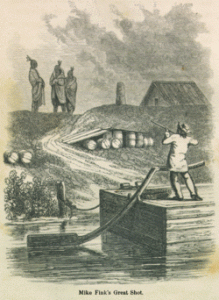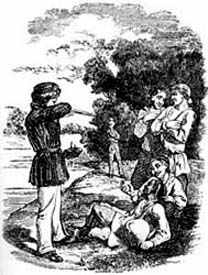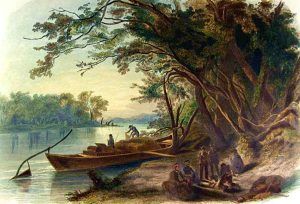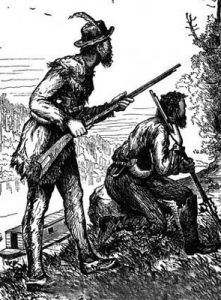By Hiram Martin Chittenden in 1902.
Mike Fink, a character in early Western history whose well-authenticated performances were so remarkable as to appear rather the creations of fancy than actual occurrences, was a native of Pittsburgh, Pennsylvania. He had little education and made fun of what he had. He used to spell his name Micke Phinck and loved to affect the extremes of barbarous jargon that characterized the language of the unlettered boatmen on the Western rivers.
Mike early became fascinated with the boatman’s life, and the sound of the boat horn was his most entrancing music. He learned to imitate its notes so that when he first took service in a keelboat, he could fill the office of trumpeter without any instrument. The river life suited his tastes, and he longed to visit its remotest ports — even New Orleans, Louisiana, where he had heard that the people spoke French and wore their Sunday clothes all week.
When the water was too low for navigation, Mike spent most of his time in Pittsburgh and its vicinity, killing squirrels and shooting at a target for beef at the frequent Saturday shooting matches and company musters of the militia.
He soon became renowned as the best shot in the country, acquiring the soubriquet of “Bangall.” Because of his extraordinary skill, he was excluded from participating in the matches. As a price for this exclusion, he was allowed the “fifth quarter” of the beef, called the hide and tallow. His usual practice was exchanging his “quarter” at a dram shop for whiskey, with which he treated everybody, mainly himself. He became fond of strong drink, but never was intoxicated. He could drink a gallon in 24 hours without showing any effects.

Mike Fink.
His language was a perfect sample of the half-horse, half-alligator dialect of the early race of boatmen. He was a good deal of wit, a quality which won him the admiration but at the same time excited the fears of the boating fraternity, for he usually enforced his jokes with a sound beating if anyone had the temerity to refuse to laugh at them. He used to say that he told his jokes to be laughed at and that no one should make light of them. The consequence was that Mike always had a band of laughing sycophants who were as afraid of his frown as a vassal might be of his lord’s displeasure.
Mike used to proclaim himself, “I am a Salt River roarer, and I love winning, and I am chock full of fight.” And indeed, he had a lady in every port who would “fight their deaths” in his defense.
Among his confederates were two men conspicuous for their prowess, who were Mike’s fast and confidential friends. Their names were William Carpenter and Levi Talbot. Each of the three was a match for the other in fighting and marksmanship and was adept in the virtues and mysteries of Mike’s calling.
Mike’s weight was about 180 pounds. He was five feet nine inches high; with a broad, round face and pleasant features; brown skin, tanned by the sun and the rain; blue but very expressive eyes, inclining to gray; broad white teeth; and square, brawny form, well proportioned, with every muscle fully developed, indicating the greatest strength and activity. Except for his stature, he was a perfect model for Hercules.
As already stated, he was an expert marksman, and many of his shooting feats have been related to those who profess to have witnessed them. On one occasion, while ascending the Mississippi River above the mouth of the Ohio River, he saw a sow with eight or nine pigs on the riverbank. He declared in a boatman’s phrase that he “wanted a pig,” and took up his rifle to shoot one. He was requested not to do so, but he nevertheless laid his rifle to his face, and as the boat glided up the river under easy sail, some 40-50 yards from shore, he shot at one pig after another, cutting their tails off close to their bodies, but not doing them any other harm!
In 1821, while standing on the levee in St. Louis, Missouri, he saw a black boy on the riverbank listlessly gazing at what was happening around him. He had a remarkably shaped foot, peculiar to some African tribes. His heel protruded to the rear so far that his foot seemed as much in the rear as in front of the leg. This unshapely form offended Mike’s eye and outraged his sense of symmetry. He determined to correct it. Lifting his rifle at 30 paces, he shot the heel away, inflicting an ugly wound. The boy dropped to the ground, screaming, “murder!” Mike was indicted in the county’s circuit court, tried, and found guilty. His plea in justification of the offense was that he wanted to fix the boy’s foot so he could wear a genteel boot. Mike’s punishment, which is not stated, could not have been very severe, for he was at liberty in the spring of 1822. Mike’s particular friend, William Carpenter, was also a great shot, and it was typical for him and Mike to fill a tin cup with whiskey and shoot it from each other’s heads at a distance of 70 yards. The feat was always performed successfully, and the cup was bored through without injury to the person supporting it. It was a favorite performance with these two men, who regarded it as a fresh avowal of their confidence in each other.
Mike had first visited St. Louis, Missouri, in 1814 or 1815 and was there frequently afterward. In 1822, he and his two friends, Talbot and Carpenter, enlisted in the company that William Henry Ashley and Andrew Henry were organizing for their attempt to open up a trade with the mountain tribes. They enlisted in the threefold character of boatmen, trappers, and hunters. The company ascended as far as the mouth of the Yellowstone River, where a fort was constructed. The party was sent out in detachments to trap on the tributaries of the Missouri and the Yellowstone Rivers. Mike and his friends, with nine others, went to the Musselshell River, where they found a warm and commodious habitation for the winter.

Mike Fink Shooting.
During their sojourn here, Fink and Carpenter had a deadly quarrel, but it was smoothed over for a time by the interposition of friends. The cause is not certainly known, but there seems to have been a woman in the case, an Indian woman for whose good graces they had become rivals. On the arrival of spring, the little party visited the fort, and here, over a draught of whiskey, they renewed their smothered quarrel. Again, they made a treaty of peace, and in evidence of their sincerity, Mike proposed that they repeat their familiar feat of shooting the whiskey cup from each other’s head. This would not only be a test of reconciliation but of mutual trust and confidence as well.
A preliminary question to be decided was which should have the first shot. To determine this, Mike proposed to “sky a copper,” or in modern phrases, to flip a copper coin. This was done, and Mike won the first shot. Carpenter, who knew from long experience the uncompromising character of Mike’s hatred, declared his belief in his companion’s treacherous intent and that he should surely be killed. But, he scorned life too much to repudiate his compact, and accordingly, he prepared to die. He bequeathed his rifle, bullet pouch, powder horn, belt, pistol, and wages to Talbot and then went to where the trial was to occur. He filled his cup with whiskey and placed it on his head while Mike loaded his rifle and picked his flint. Carpenter stood erect and serene at the proper place without a change of countenance to indicate what was passing in his mind. Mike leveled his rifle at a distance of 60 yards. After drawing a bead, he took down his rifle and smilingly said: “Hold your noddle steady, Carpenter, and don’t spill the whiskey, as I shall want some presently.” He again raised his rifle, and in an instant, Carpenter fell, dying without a groan. The ball had penetrated his forehead in the center, an inch and a half above the eyes. Mike coolly set the breech of his gun on the ground, and, applying his mouth to the muzzle, blew the smoke out of the barrel while keeping his eye upon the prostrate form of his old-time friend. Finally, he said: “Carpenter, you have spilled the whiskey!” He was told that he had killed Carpenter. “It is all a mistake,” he said, “for I took as fine a bead on the black spot on the cup as I ever took on a squirrel’s eye. How did it happen”? He then cursed his rifle, the bullet, and finally himself.
In this remote region where the power of the law was not yet known and among a party who had an exaggerated dread of Mike’s prowess, the crime was permitted to pass off as an accident, and Mike was allowed to go at large. But, Levi Talbot, Carpenter’s fast friend, was convinced of Mike’s treacherous intent and resolved upon revenge whenever opportunity should offer. Some months afterward, Mike, in a fit of boastful talk, declared that he had killed Carpenter on purpose and was glad of it. Talbot instantly drew his pistol, the same which Carpenter had bequeathed him, and shot Mike through the heart. Mike fell and died without a word.
Talbot likewise was not called to account, for nobody had any authority to do so, and few doubtless felt any inclination, as it was probably considered a just penalty for the killing of Carpenter. Moreover, Talbot was a terrible enemy, ferocious and dangerous as a grizzly of the prairies. About three months later, he was present in the Arikara battle under Colonel Henry Leavenworth, where he displayed a coolness that would have done honor to a better man. He came out of the battle unharmed, but about ten days later, while attempting to swim the Teton River, he drowned.
Remarkable as this story is, it has authentic confirmation. In General Clark’s letter book on Indian Affairs, now in possession of the Kansas Historical Society at Topeka, there is a list of deaths among the Ashley, Smith, Jackson, and Sublette parties before 1830. The statement says that in 1822, Mike Fink shot William Carpenter; that Fink was soon after shot by Levi Talbot, who was later drowned in the Teton River. The year should be 1823.
The following notice appeared in the St. Louis Republican of July 16, 1823:
“By a letter received in town from one of General Ashley’s expeditions, we are informed that a man by the name of Mike Fink, well known in this quarter as a great marksman with the rifle, and is the same who some time since in this place shot off a black boy’s heel to enable him, as he said, to wear a genteel boot! He was engaged in his favorite amusement of shooting a tin cup from the head of another man when, by aiming too low or from some other cause, he shot his companion in the forehead and killed him. Another man of the expedition (whose name we have not yet heard) remonstrated against Fink’s conduct, to which he (Fink) replied that he would kill him likewise, upon which the other drew a pistol and shot Fink dead on the spot.”
Compiled and edited by Kathy Alexander/Legends of America, updated June 2025.
About the Author: This article was written by Hiram Martin Chittenden and included in his book, The American Fur Trade of the Far West, published in 1902. Chittenden served in the Corps of Engineers, eventually reaching the rank of Brigadier General. He was in charge of many notable projects during this time, including work at the Yellowstone and Yosemite National Parks and the Lake Washington Canal Project. He was also an author, penning historical volumes, tour guides, and poetry. As it appears here, the story is not verbatim, as it has been edited for clarity and ease for the modern reader.
Also See:
List of Old West Explorers, Trappers, Traders & Mountain Men


